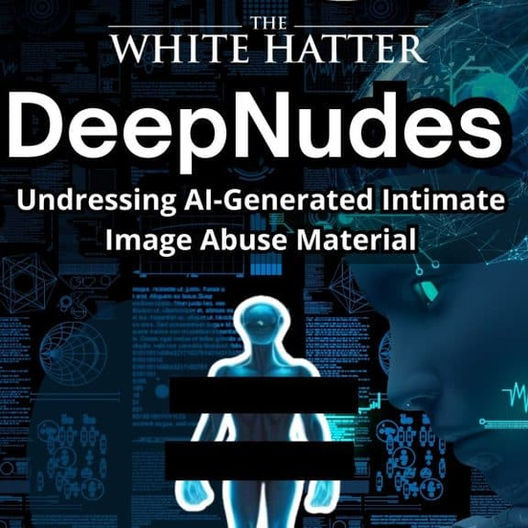ALERT - Why This New AI Tool Is a Wake-Up Call for Parents, Caregivers, and Legislators
- The White Hatter

- Apr 4
- 5 min read
Updated: May 12

CAVEAT - The field of artificial intelligence (AI) is evolving at such a rapid pace that developers often overlook a safety-by-design approach, particularly when it comes to preventing misuse by bad actors who may weaponize this technology against youth and teens. Their primary focus? Be first to market and prioritize profit above all else.
We’ve been raising the alarm about AI-generated deepfake nude images and videos for some time now. (1) These tools, which once felt like something out of a sci-fi movie, are very real, and very accessible. But a new development by ByteDance, the company behind TikTok, takes this concern to a whole new level.
Recently, ByteDance publicly released the framework for DreamActor-M1, an AI-driven tool that creates full-body, photorealistic human animations with expressive gestures, lip-syncing, and emotions. Originally marketed for filmmakers, creators, and gamers, DreamActor-M1 is being hailed as a breakthrough in digital character animation. Here’s a Youtube Video that demonstrates the capabilities of this software:
Yes, the technology is impressive. But it’s also terrifying when you start to think about the unintended uses,especially when it comes to our kids.
NOTE - ByteDance has not disclosed specific plans regarding the commercialization or widespread availability of DreamActor-M1. Therefore, while the framework has been publicly announced and its research findings shared publicly, it is not yet clear whether the tool is available for public use or integration into consumer applications, BUT it is only a matter of time before it is given the race to be first when it comes to monetizing AI technology.
Let’s break this down.
What Is DreamActor-M1?
DreamActor-M1 is a piece of AI software that can turn a single picture of a person into a highly realistic, full-body animated version of them or any other person. It captures facial expressions, body movements, and even emotional tone. It can animate people from a single image or short clip and map those expressions onto other digital forms with shocking accuracy.
While the focus of this software is on how it can revolutionize filmmaking or video game development, we guarantee that this technology will also be weaponized and misused, especially by those who prey on children and teens online. Here’s how:
1. AI-Driven Sexual Exploitation
AI has already been used to create fake nude images of real children, often by pulling photos from their own social media profiles, or even those of their parents or caregivers accounts (2) DreamActor-M1 allows for the movement of those fake images, turning still photos into full-body, animated videos. This means someone could potentially create realistic videos of a teen or child doing things they never actually did. The potential for abuse here is staggering.
2. Cyberbullying & Digital Peer Aggression
Imagine a high school student’s face being mapped onto a video that shows them saying or doing something humiliating or offensive. Now imagine that video going viral across their entire school. These “deepfake pranks” might be seen as jokes by some, but they can destroy reputations, friendships, and mental health, something we have already seen with “squish” AI technology (3)
3. Online Predation
Offenders could use this software to create fake but extremely believable personas, digital puppets of children or teens, to groom others. It's not far-fetched to think of someone using this to pose as a peer and manipulate another child into unsafe interactions. We have already helped several teens who were targeted this way
4. Fake Political Speeches & Viral Misinformation
Yes, we’re talking about kids, but it’s also worth noting that this tech can be used to create realistic videos of political figures, celebrities, or authority figures saying things they never said. These clips could go viral, mislead the public, or fuel disinformation campaigns, something even young people can get caught up in and be influenced by. These types of video already flood the internet, this technology will just make them even more realistic.
5. Mass-Scale Identity Theft
The ability to animate a person’s face and body means identity thieves can now produce convincing videos for scams, fraud, or impersonation. (4) Imagine a scammer calling a teen’s parent with a fake video of their child in distress, asking for money. It’s not only possible now, it’s getting easier and cheaper to do.
DreamActor-M1, as well as several other AI image creating software coming to market, isn't just another piece of tech, it’s a wake-up call for parents, caregivers, educators, and legislators.
One of the most important conversations parents and caregivers can have with their children today is about the power, and risk, of sharing images online. Kids and teens need to understand that once a photo is posted, it can be taken, altered, and used in ways they never intended. Even something as innocent as a smiling selfie can become the raw material for a manipulated or sexually explicit deepfake. (5) Make it clear that their digital dossiers matters, and that they should think carefully about what they share and who they share it with.
Equally vital is helping your child develop a healthy sense of skepticism about what they see online. In a world where AI can make anyone say or do anything on screen, it’s crucial they learn to question what’s real and what’s not. Show them examples of deepfake content and talk about how it was created. Explain that viral videos and even livestreams can be manipulated. Teaching them how easily digital content can be faked empowers them to think critically and avoid being deceived by misinformation or targeted by digital scams.
Parents and caregivers can also play a role in pushing for stronger protections at a broader level. The release of powerful tools like DreamActor-M1 should serve as a wake-up call that we need stronger legislation and ethical guidelines to keep pace with rapidly evolving AI technologies. (6) Advocate for digital literacy programs in schools and support policies that hold tech companies accountable for how their tools are used, especially when children are involved. (7) Safety shouldn’t be optional in the development of emerging technologies.
Education and understanding are the most effective tools we have. By staying informed about what these technologies can do, and by having open, honest conversations about them, we can better prepare our children to face the onlife world with resilience and confidence. It’s not about scaring them; it’s about equipping them to deal with online dilemmas.
Technology is evolving rapidly. What once took teams of professionals to do in Hollywood now takes a few clicks by anyone, including those who want to target our kids. DreamActor-M1 is just the latest example of how powerful tech can be both a tool for creation and a tool for exploitation.
Let’s be clear: This isn’t about banning tech or demonizing innovation. It’s about understanding the risks, having the conversations, and helping our kids navigate an increasingly complex digital world with confidence and critical thinking.
Want more resources on how to talk to your kids about AI, social media, and online safety? Visit us at www.thewhitehatter.ca. We’re here to help parents, caregivers and educators stay ahead of the curve in today’s onlife world.
Digital Food For Thought
The White Hatter
Facts Not Fear, Facts Not emotions, Enlighten Not Frighten, Know Tech Not No Tech
References:














